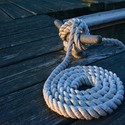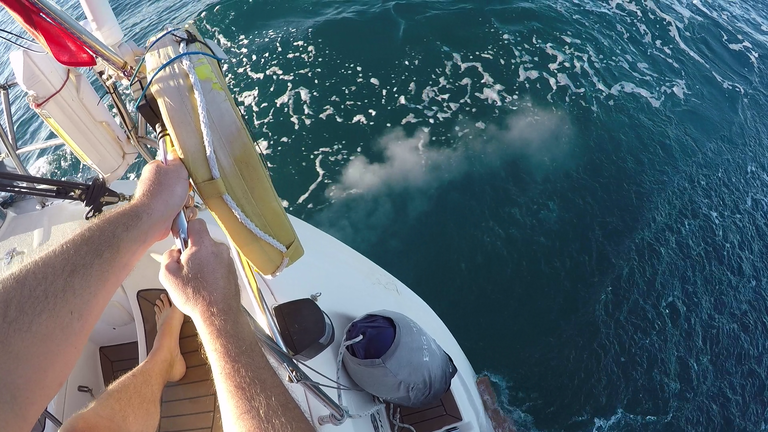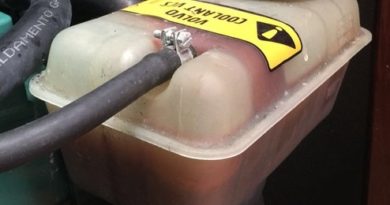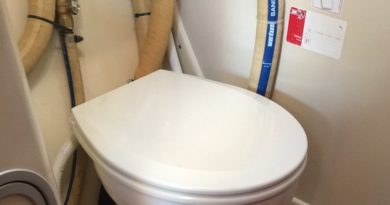Marine diesel white smoke from exhaust
White smoke from the exhaust of your marine diesel can be worrying but the below are some diagnostic checks to narrow it down before forking out for a mechanic.
Marine diesel white smoke from exhaust
Lets face it, any time we see smoke coming out of our engine we start to see dollar signs flash before our eyes however there are a number of things that could cause your engine to smoke. If you’ve found this page you will likely already have taken a look and concluded that you are getting white smoke and would like to take a step further to investigate the cause.
There’s white smoke and then there’s white smoke
Usually with white smoke you’re either spitting out vaporous un-burned diesel or steam.
To tell the difference between the two is fairly easy, if your engine is making white smoke right from start up and the smoke sits on the water without disappearing you’re most likely looking at un-burned diesel. This is usually caused by:
- Dirty or damaged fuel injectors
- Problems with the injection timing (worn timing belt)
- Loss of cylinder compression (damaged valves, piston ring ware or cylinder glaze)
Unless you feel confident about removing injectors for service this is a job best left to a competent diesel mechanic.
White smoke that quickly disappears
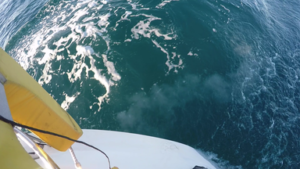 This is the most common type of white smoke and with luck easier to remedy. With white smoke that quickly disappears after a couple of yards behind the boat, you’re most likely looking at steam. There are two possible sources to create steam in your marine diesel engine one is from coolant and the other is from the raw water drawn into your engine to cool the coolant.
This is the most common type of white smoke and with luck easier to remedy. With white smoke that quickly disappears after a couple of yards behind the boat, you’re most likely looking at steam. There are two possible sources to create steam in your marine diesel engine one is from coolant and the other is from the raw water drawn into your engine to cool the coolant.
Testing this is fairly straight forward, mark the level of coolant in your expansion tank then run your engine for a period of time where white smoke is being produced and monitor your coolant levels. If there is no measurable reduction in coolant (remember to allow for expansion of the coolant into the chamber) then you can be sure you are turning sea water into steam. This means part of your engine is running too hot… most likely near the outlet manifold and exhaust elbow where the sea water and exhaust gasses mix.
Marine diesel engine raw water throughput
Next you want to test if you are getting sufficient raw water pumped through to cool your engine. to do this check your manufacturer spec which should tell you how many liters (or gallons) per minute your engine pumps at a specific revs. For example, a Volvo Penta D1-30 should pump 18 liters of sea water per minute at 1200 revs. The next step will require a helper with a stopwatch and possibly a dingy depending on access to your exhaust. Get your engine running at the correct revs, get your buddy ready with the stopwatch and hang the bucket under the exhaust. You can do 30 seconds then multiply by 2 to get your per minute throughput.
Nine times out of ten white steam is down to reduced raw water flow which could be caused by:
- Clogged up heat exchanger
- Damaged impeller or leaky impeller housing
- An obstruction clogging the raw water inlet or debris clogging your raw water filter.
- Growth reducing raw water flow in your sail drive (if you have one)
If you have reduced cooling water flow, start with the easy fixes and check the raw water sea strainer for debris and clean it out.
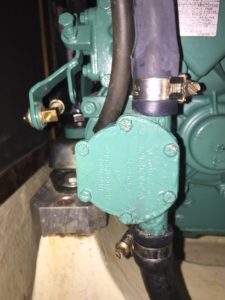 Next check and replace your raw water impeller… this you should do annually but if it’s been a while this could be your culprit. Make sure you replace the gaskit properly to ensure the housing seals up tight. You should also introduce some glycerin or dish soap into the housing before closing up to make sure the impeller does not get damaged while running dry before the water come up.
Next check and replace your raw water impeller… this you should do annually but if it’s been a while this could be your culprit. Make sure you replace the gaskit properly to ensure the housing seals up tight. You should also introduce some glycerin or dish soap into the housing before closing up to make sure the impeller does not get damaged while running dry before the water come up.
Next, if you have a saildrive and suspect debris or growth is blocking the water flow you can collect an alternative raw water pipe to the input of your sea strainer. for this you would need an alternative through hole available and a suitable pipe to connect them such as the inlet for your water maker or through hull to the galley sea water pump etc. at a pinch you could run a pipe overboard. A clogged sail drive is a common culprit and it’s good practice to give it a flush out with vinegar or another growth inhibiting treatment when next on the hard.
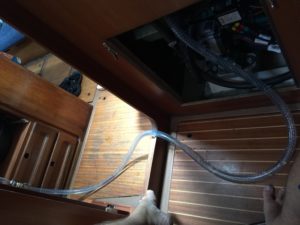 If the sail drive is clogged a good trick is to connect a hose up to the inlet stop cock and reverse flush with full pressure to wash out whatever is obstructing the water flow. If there is stubborn marine growth in there you can pickle it by pouring a few liters of strong cleaning vinegar down into the sail drive from the raw water pipe and keep topping it off every couple of hours. after a day or two reverse flush again and wash out the rubbish.
If the sail drive is clogged a good trick is to connect a hose up to the inlet stop cock and reverse flush with full pressure to wash out whatever is obstructing the water flow. If there is stubborn marine growth in there you can pickle it by pouring a few liters of strong cleaning vinegar down into the sail drive from the raw water pipe and keep topping it off every couple of hours. after a day or two reverse flush again and wash out the rubbish.
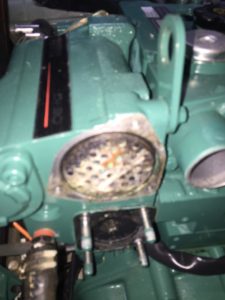 If the sail drive is NOT clogged but you are still getting restricted water flow, your culprit could be silting up or calcification of your heat exchanger. To avoid taking this apart a good trick is to suck up a few liters (gallon or so) of piping hot vinegar into the heat exchanger unit and let it pickle overnight. To do this, first run your engine up to temperature so it’s nice and warm. Next, shut down the engine and disconnect the pipe from the raw water filter that leads to your raw water pump, feed it into your pot of freshly heated vinegar (don’t sniff the vinegar… it’s horrible) and have someone run the engine for a few seconds while the hot liquid is sucked up into the heat exchanger. have them turn it off just as the vinegar comes to an end so the system is full of the liquid. This will slowly fizzle and break down the crud that has collected inside the walls of your exchanger unit. Connect up your pipes again and leave the mix overnight to pickle. next day fire up your engine and test for water throughput again and see how you go.
If the sail drive is NOT clogged but you are still getting restricted water flow, your culprit could be silting up or calcification of your heat exchanger. To avoid taking this apart a good trick is to suck up a few liters (gallon or so) of piping hot vinegar into the heat exchanger unit and let it pickle overnight. To do this, first run your engine up to temperature so it’s nice and warm. Next, shut down the engine and disconnect the pipe from the raw water filter that leads to your raw water pump, feed it into your pot of freshly heated vinegar (don’t sniff the vinegar… it’s horrible) and have someone run the engine for a few seconds while the hot liquid is sucked up into the heat exchanger. have them turn it off just as the vinegar comes to an end so the system is full of the liquid. This will slowly fizzle and break down the crud that has collected inside the walls of your exchanger unit. Connect up your pipes again and leave the mix overnight to pickle. next day fire up your engine and test for water throughput again and see how you go.
